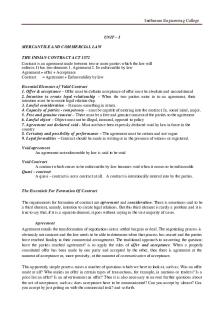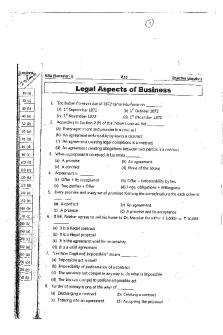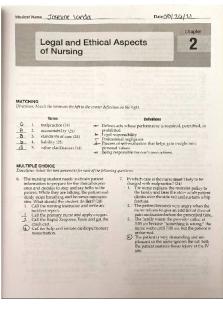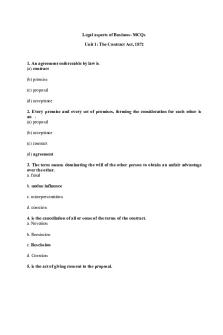BLAW 422 - Chapter 6 - The Legal Aspects of Credit PDF

| Title | BLAW 422 - Chapter 6 - The Legal Aspects of Credit |
|---|---|
| Author | Devin Blair |
| Course | Law of Business Organizations |
| Institution | University of Alberta |
| Pages | 10 |
| File Size | 194.4 KB |
| File Type | |
| Total Downloads | 62 |
| Total Views | 107 |
Summary
Chapter 6 – The Legal Aspects of Credit Introduction to Debt and Credit Some credit arrangements are formal and deliberate, with carefully negotiated terms, while others are an incidental feature of routine transactions Credit is a contractual relationship with the lender agreeing to lend money ...
Description
Chapter 6 – The Legal Aspects of Credit Introduction to Debt and Credit Some credit arrangements are formal and deliberate, with carefully negotiated terms, while others are an incidental feature of routine transactions Credit is a contractual relationship with the lender agreeing to lend money in exchange for a promise by the borrower to repay the loan o Usually repaid with interest and within a certain time frame o All fundamental principles of contract law apply to credit, as well as additional legal regulations and specific principles Credit can be secured or unsecured o Secured Credit: A debt where the creditor has an interest in the debtor’s property to secure payment If the debtor defaults in repaying the loan, the secured creditor can seize the secured property and sell it to pay down the debt o Unsecured Credit: A debt where the creditor has only a contractual right to be repaid The unsecured creditor does not have an interest in the property of the debtor that it can enforce in the event of default by the debtor If the debtor defaults, a secured creditor is in a much better position than an unsecured creditor Trade credit is usually unsecured o In most cases, payment is made within the designated time period and collection remedies are not needed o Since they are unsecured, if a debtor fails to pay on time, the creditor may have to due the debtor, obtain judgement, and then enforce the judgement o If the debtor has limited financial resources, the creditor may end up not being paid Because of this, it is important for creditors to use good judgement for deciding whether to extend credit o Can be risky if the parties have not dealt with each other before, especially if the supplier and customer are located in different countries Business can also decide to raise a significant amount of capital by borrowing o Tend to be more formal and provide more security to the lender; rights and obligations are carefully negotiated o Generally used to purchase a major asset or finance expansion o If applying through a bank, two steps (creditor ensures that they will be repaid): They will look at the company’s financial health (likelihood plans will succeed, reasonable repayment) Investigate the security the company can provide (i.e. If they cannot repay the loan, they want to ensure that it can seize property and sell it to pay the outstanding loan regardless of business success) A lender will consider the ability of the debtor to repay the loan, the value of the security that the debtor can provide, the state of the economy, the industry the debtor carries on business, whether personal guarantees are available, and the state of the credit markets o Based on all of these considerations, the lender will decide whether to grant the loan and, if so, on what terms o The lender will set the interest rate at a level that corresponds to the riskiness of the loan from the lender’s perspective o Terms of the agreement are negotiated by the parties, which include repayment terms, interest, security, fees, and events of default Events of Default: Failure by the debtor to make required payments on a loan or to fulfil its other obligations under the credit agreement o Normally, both the borrower and lender will have their own lawyers to advise them on the credit agreement In most cases, the legal and other fees of the lender must be paid by the borrower Methods Used to Reduce Risk in Credit Transactions 1. Creditors should employ good credit policies and procedures o Involves having debtors fill out credit applications and checking debtor’s credit references o Easiest and most inexpensive way to minimize risk of default = do not land to people who will not pay it back 2. Creditors may be able to change the structure of a transaction so that it is not a credit arrangement at all o i.e. A supplier of equipment may choose to lease the equipment rather than sell it, so that the supplier retains ownership of the equipment in event of default, the lessor can usually repossess the equipment 3. Creditors may insist on security/collateral, to back up the borrower’s promise to pay o Collateral: Property in which a creditor takes an interest as security for a borrower’s promise to repay a loan o If a creditor is able to seize property of the debtor and sell it to pay down the debt reduced risk 4. Creditors often include terms in credit agreements which require debtors to carry on business in accordance with specific requirements o i.e. A credit agreement may require the debtor to refrain from making significant capital expenditures or allowing certain financial ratios to fall below defined limits
It is important for businesspeople to think of themselves as creditors any time they are extending credit o In many cases, supplies will extend credit to customers but fail to take any measures to reduce the risk of not being paid o Banks and sophisticated creditors employ the techniques described above in order to reduce their risk – businesspeople who extend credit would be wise to think along similar lines
The Credit or Loan Agreement In the case of trade credit, the agreement between the debtor and the creditor is usually informal and may even be verbal
If written, they will often be on a standard form document such as a purchase order or a set of terms and conditioned provided by the suppliers In the case of a large debt financing, however, the credit agreement is typically called a “loan agreement”; is much more comprehensive and carefully negotiated by the parties o The process of applying for a loan and formulating the terms of credit is much the same as for the negotiation of any other contract o If the bank decides to grant the loan, it will usually provide a letter of commitment Letter of Commitment: o The terms may include Amount of the loan and how it will be disbursed Rate of interest, and whether it is floating or fixed Repayment terms, including the amount and frequency of payments Term of the loan and conditions for renewal (if the entire loan will not be paid out during the term) Conditions that must be satisfied before the loan is made (i.e. guarantees, appraisals) Security or collateral required by the lender Requirements for maintenance of the borrower’s financial position Events that constitute default and the lender’s remedies Fees to paid by the borrower The borrow is free to try and negotiate the terms set out in the letter of commitment, or to try to negotiate with other potential lenders, but the final say over whether the loan will be made is that of the lender o Once the letter of commitment is signed by the borrower, the lender will prepare a more formal and comprehensive loan agreement o The loan agreement will cover all of the terms and conditions set out in the letter of commitment Often accompanied by other agreements, such as mortgage, security agreement, or personal guarantee o
Security In order to reduce the risk of non-payment, a lender may require that the borrower provide security/collateral o Collateral can be either real property (accomplished through a mortgage) or personal property o While the loan obligation is evidenced by the credit/loan agreement, the taking of security is normally covered by a separate security agreement Lenders will often try to match their security to the use of the loan proceeds o i.e. If X borrows money in order to buy a new piece of equipment, the security for the loan may be the equipment itself o The most attractive collateral to a lender is that which is most liquid (most easily converted into cash) If the bank decides to land money to fund its planned expansion, the bank will likely require a general security agreement and all afteracquired property o General Security Agreement: A security agreement that includes all of the debtor’s personal property assets as collateral o After-Acquired Property: Collateral that includes personal property acquired by the debtor during the term of the loan Some assets used as collateral are intended to be retained by the debtor o i.e. If a company buys a forklift for use in its warehouse, the forklift is availbe as security for its entire useful life May be a provision that prohibits the sale of the forklift while the loan is outstanding o i.e. Inventory and accounts receivable are meant to calculate through the business on a regular basis; the security in these assets is their value at any given time Security agreement will allow the sale of inventory in the ordinary course of business The type and extend of security that a lender requires will depend on several factors, including the risk of default and the market value of the collateral – including the risk of default and the market value of the collateral o Credit insurance may be available to lenders as an additional source of protection against the risk of uncollectible accounts Personal Property Security Legislation When considering whether to grant secured credit, lenders must be confident as to their position with respect to the collateral Every province and territory has legislation in place to provide an orderly system for recognizing interests in personal property collateral and setting out rules to determine priority disputes among competing claim to the same collateral The personal property security systems allow lenders to grant credit, knowing where they will stand with respect to the collateral in the vent of default by the debtor The legislation in each province and territory (except Quebec) is called “Personal Property Security Act” (PPSA) o Applies to every transaction that in substance crates a security interest o Security Interest: An interest in personal property that is intended to secure payment or performance of an obligation (usually a debt) Even if the transaction is called something else (i.e. a lease or a conditional sale), if its real purpose is to create an interest in personal property to secure payment or performance of an obligation (normally a debt), the transaction is a security interest and the PPSA applies o PPSA also applies to some transactions that are not intended as security, such as leases for a term of more than one year, commercial consignments (except in Ontario), and absolute assignments (transfers) of accounts (such as accounts receivable) Attachment Attachment occurs when three conditions are satisfied: o The debtor has rights in the collateral (i.e. ownership) o The secured party has provided value (i.e. Granted a loan or extended credit)
o The debtor has signed a written security agreement Once attachment has occurred, the security interest is enforceable against the debtor
Perfection Perfection is a combination of (a) attachment and (b) registration or possession of the collateral o Registration: The registration of a financing statement to record a security interest Once a security interest has been perfected, the secured party will have priority over security interests that have not been perfected, as well as judgement creditors and a trustee in bankruptcy Registration involves filing a form called a “financing statement” o Financing Statement: The document registered as evidence of a security interest o Discloses the name of the debtor and the type of collateral secured o The PPSA registration system is computerized and public can be searched either by debtor name, or, in the case of motor vehicles, by serial number Possession, for the purposes of perfection, occurs when the secured party physically takes possession of the collateral for the purposes of holding it as security o i.e. If someone wanted to pledge a gold bar as security, the lender might take physical possession of the gold bar until the loan is repaid – in that case, assuming attachment has occurred, the lender will have a security interest perfected by possession The most common form of perfection is by registration o When a person searches the PPSA register and discovers a financing statement of interest to them, they can find out the details of the security interest to which that financing statement relates by making an inquiry to the secured party Perfection is not “perfection” in the sense that it confers the best possible interest one can have in the collateral – it does not o The term “perfection” is simply a defined term in the PPSA and it has only the specific meaning given to it within that legislation Perfection may occur even if attachment occurs after registration (Except when dealing with consumer goods) o If someone applies for the loan, the bank may register a financing statement under the PPSA o If the loan has not yet been granted, there has been no attachment o However, once the conditions for attachment have been met, the security interest will immediately be perfected, because registration has already occurred Priority Among Creditors One of the most important functions of the PPSA is to determine who has priority when there are competing interests in the same collateral o The PPSA has rules to resolve such conflicts General policy behind the priority rules is that a security interest has been made public (i.e. by registration) should have priority over a subsequent interest in the same collateral, except where specific policy objectives warrant a different outcome The priority rules produce predictable outcomes, which promotes the extension of credit generally: o When there are two unperfected security interests that have both attached, the first to attach has priority o When there is one unperfected security interest and one perfected security interest, the perfected security interest has priority o When there are two security interests perfected by registration, the first to register (not the first to perfect) has priority There are other priority rules dealing with specific types of collateral and security interests perfected otherwise than by registration The purchase-money security interest (PMSI) is a special type of security interest that gives the secured party priority over existing perfected security interests o Purchase-Money Security Interest (PMSI): A security interest that enables the debtor to acquire assets and gives the secured party priority over existing perfect security interests o In order to qualify for this “super priority”, two conditions must be must: The credit advanced must allow the debtor to acquire the assets in which the security interest is taken The security interest must be registered within a specific period of time o If these conditions are met, the PSMI holder will have priority over an existing perfected security interest in the collateral that was financed Transfer of Collateral Generally, perfected security interests follow the collateral and take priority over subsequent purchasers of the collateral Why when is it not necessary to conduct a PPSA search every time an item is bought in a retail store? The reason is the exemption for goods sold in the ordinary course of business The PPSA contains a provision which gives priority to a buyer who buys goods in the ordinary course of the seller’s business The computerized and centralized system associated with the PPSA is a vest improvement over the earlier patchwork of different statutes and rules within each province dealing with the personal property security interests There are rules in the PPSA to deal with the relocation of collateral, but they are complicated and vary by jurisdiction o Lenders and borrowers must both be informed of the rules that apply in the jurisdiction in which they carry on business and in which collateral may be, or end up being, located The PPSA system provides potential collateral creditors and buyers with a high level of protection o A lender can search the PPSA registry before granting credit to determine whether there are existing registrations against the borrower o The creditor can even register a financing statement in advance of granting credit, to ensure its priority position will be undisturbed even it eventually grants the loan
o
o
Purchasers of goods can search the PPSA registry to determine whether the goods are subject to a security interest that would take priority over them This knowledge allows creditors and debtors to make informed business decisions with the confidence of knowing where they will stand in the event of a default by the debtor The same assets can provide security for more than one credit arrangement, but the claims of competing lenders are subject to the priority rules described above A lender may decide to grant a loan, even with the knowledge that there are existing security interests in the same collateral, but presumably the lender will tailor the terms of the loan, and in particular the interest rate, to suit the particular circumstances
Other Security Legislation The federal Bank Act permits banks to take security in the inventory and other assets of certain business borrowers o Bank Act security is only available to banks that are regulated by the Bank Act o Bank Act security is registered, but the registration system is quite different from that of the PPSA system o Priority disputes between Bank Act security and PPSA security are complicated and have resulted in a great deal of litigation o In 2012, amendments were made to the Bank Act which may help resole some of these priority disputes Each province and territory has legislation which allows suppliers, building subcontractors, and workers to place liens on real property if they are not paid for work done, or materials supplied, to the property o These liens are called construction or builders’ liens and they remain in place until the supplier, subcontractor, or worker has been paid in full o The legislation requires property owners who enter into contract with builders to hold back a portion of the contract price until the lien period has expired (usually between 30-60 days after the contract work is completed) o This mechanism provides an incentive for contractors to pay their suppliers and subcontractors in a timely manner Remedies A creditor’s remedies in the event of the borrower’s failure to pay are largely determined by whether the creditor is secured or unsecured Unsecured creditors have the right to sue the debtor for the unpaid debt and may, at the end of that litigation process, obtain a judgement against the debtor o In most cases, the unsecured creditor will then be able to enforce its judgement against the assets of the debtor that are not already claimed by secured creditors Secured creditors also have the right to sue the debtor, but in addition, they can immediately seize the collateral and sell it to pay down the debt owed o Ability to seize the personal property of the debtor without having to commence litigation places the secured creditor in a much better position than the unsecured creditor Furthermore, if the debtor ends up being bankrupt, the secured creditor will still be able to claim its collateral, while the unsecured creditor will have no remedy except under the bankruptcy proceedings Lender’s Remedies If the borrower defaults on the loan, secured parties have a variety of remedies from two sources: the security agreement and the PPSA o The remedies provided for in security agreements after often broader than those permitted by the PPSA, in which case the secured party is generally limited to the remedies permitted by the PPSA Credit agreements normally contain an acceleration clause o Acceleration Clause: A term of a loan agreement that makes the entire loan due if one payment is missed o Provides an inventive for a debtor to make timely payments and allows the creditor to sue for the entire debt immediately upon any default by the debtor A secured party can enter the borrower’s premises and seize the collateral immediately upon default by the debtor, although the secured party mist not break the law and is generally required to provide advance notice to the debtor o The secured party can then dispose of the collateral (or collect collateral such as accounts receivable) o The proceeds are applied first to the expenses of the secured party in enforcing its security and ...
Similar Free PDFs

Legal Aspects of Nursing
- 5 Pages

MCQ - Legal Aspects of Business
- 25 Pages

Legal Aspects of Business MCQs
- 26 Pages

BLAW Brief (Chapter 14)
- 1 Pages
Popular Institutions
- Tinajero National High School - Annex
- Politeknik Caltex Riau
- Yokohama City University
- SGT University
- University of Al-Qadisiyah
- Divine Word College of Vigan
- Techniek College Rotterdam
- Universidade de Santiago
- Universiti Teknologi MARA Cawangan Johor Kampus Pasir Gudang
- Poltekkes Kemenkes Yogyakarta
- Baguio City National High School
- Colegio san marcos
- preparatoria uno
- Centro de Bachillerato Tecnológico Industrial y de Servicios No. 107
- Dalian Maritime University
- Quang Trung Secondary School
- Colegio Tecnológico en Informática
- Corporación Regional de Educación Superior
- Grupo CEDVA
- Dar Al Uloom University
- Centro de Estudios Preuniversitarios de la Universidad Nacional de Ingeniería
- 上智大学
- Aakash International School, Nuna Majara
- San Felipe Neri Catholic School
- Kang Chiao International School - New Taipei City
- Misamis Occidental National High School
- Institución Educativa Escuela Normal Juan Ladrilleros
- Kolehiyo ng Pantukan
- Batanes State College
- Instituto Continental
- Sekolah Menengah Kejuruan Kesehatan Kaltara (Tarakan)
- Colegio de La Inmaculada Concepcion - Cebu











